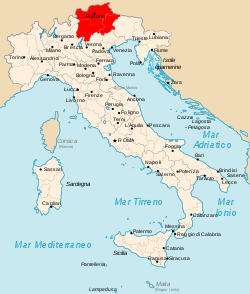- Operational Zone of the Alpine Foothills
-
Operationszone Alpenvorland (de)
Operational Zone of the Alpine FoothillsAdministrative district of Nazi Germany ← 
1943–1945  →
→

Flag Coat of arms The Operational Zone of the Alpine Foothills (OZAV) Capital Bozen High Commissioner - 1943–1945 Franz Hofer History - Establishment 1943 - Disestablishment 1945 The Operational Zone of the Alpine Foothills (German: Operationszone Alpenvorland (OZAV); Italian: Zona d'operazione Prealpi) was a Nazi German district in the sub-Alpine area created in Italian territory during World War II. It was administered as part of the Reichsgau of Tyrol-Vorarlberg. The capital of the zone was Bolzano.
OZAV was established on 10 September 1943 by the occupying German Wehrmacht, as a response to the Allied Armistice with Italy proclaimed two days earlier following the Allied invasion of Italy. It comprised the provinces of Belluno, South Tyrol and Trentino. The Operational Zone of the Adriatic Littoral, comprising the provinces of Udine, Görz, Trieste, Pula, Rijeka, Kvarner Gulf and Ljubljana, was established on the same day. Both operation zones formally belonged to the Italian Social Republic, which governed those areas of Italy administered from Salò at Lake Garda and not yet occupied by the Allies. The Italian influence was resisted and dismantled by the Germans, who decreed the restoration of the provincial borders of 1919 (plus the addition of Belluno), and forced the resignation of the ethnic Italian speaking mayors in South Tyrol who were replaced by German-speaking mayors recruited from the local population identifying with the Third Reich. In short order, the Italian names of streets and localities were replaced by German names. The effect was a rapid and draconian reversal of the stringent policy of Italianization which had been imposed on the region by the Italian government beginning in the early 1920s.
OZAV was administered by High Commissioner Franz Hofer, who banned political parties and disenfranchised the Italian administration in the region, replacing it with "suitable representatives of the German group of peoples."[citation needed] Military units in the region came under the Befehlshaber Operationszone Alpenvorland commanded by General der Infanterie Joachim Witthöft, a former divisional commander in the XXVII Corps of the German Army (Wehrmacht Heer).
Primary enforcement of German regulations was performed by the Südtiroler Ordnungsdienst (SOD, the "South Tyrol" civil police), which had been recruited from the ADO (Arbeitsgemeinschaft der Optanten für Deutschland or Association of Optants for Germany); it was mirrored in Trento (Trentino) by the Corpo di Sicurezza Trentino (CST) and in the Belluno province by the Corpo di Sicurezza Bellunese (CSB), both composed of people drafted from all male residents between the eighteen and fifty years of age. The SOD was also actively involved in the pursuit of the Jews and the well-known “Dableiber” (those who had chosen Italy when they were compelled to declare their allegiance), like Michael Gamper, Friedl Volgger, Rudolf Posch and Josef Ferrari. Many of the Dableiber were current or former Catholic priests and were persecuted by the Germans.
See also
 Administrative divisions of Nazi Germany
Administrative divisions of Nazi GermanyGaue Gau Baden · Gau Bayreuth · Gau Berlin · Gau Düsseldorf · Gau Essen · Gau Franken · Gau Halle-Merseburg · Gau Hamburg · Gau Hessen-Nassau · Gau Köln-Aachen · Gau Kurhessen · Gau Magdeburg-Anhalt · Gau Mainfranken · Gau Mark Brandenburg · Gau Mecklenburg · Gau Moselland · Gau München-Oberbayern · Gau Niederschlesien · Gau Oberschlesien · Gau Ost-Hannover · Gau Ostpreußen · Gau Pommern · Gau Sachsen · Gau Schleswig-Holstein · Gau Schwaben · Gau Südhannover-Braunschweig · Gau Thüringen · Gau Weser-Ems · Gau Westfalen-Nord · Gau Westfalen-Süd · Gau Westmark · Gau Württemberg-HohenzollernReichsgaue Reichsgau Danzig - Westpreußen · Reichsgau Flandern · Reichsgau Kärnten · Reichsgau Niederdonau · Reichsgau Oberdonau · Reichsgau Salzburg · Reichsgau Steiermark · Reichsgau Sudetenland · Reichsgau Tirol-Vorarlberg · Reichsgau Wallonien · Reichsgau Wartheland · Reichsgau WienOperational zones Autonomous regions Other districts Categories:- States and territories established in 1943
- States and territories disestablished in 1945
- World War II occupied territories
- History of Tyrol
- 1943 establishments
- 1945 disestablishments
- Italy in World War II
Wikimedia Foundation. 2010.

